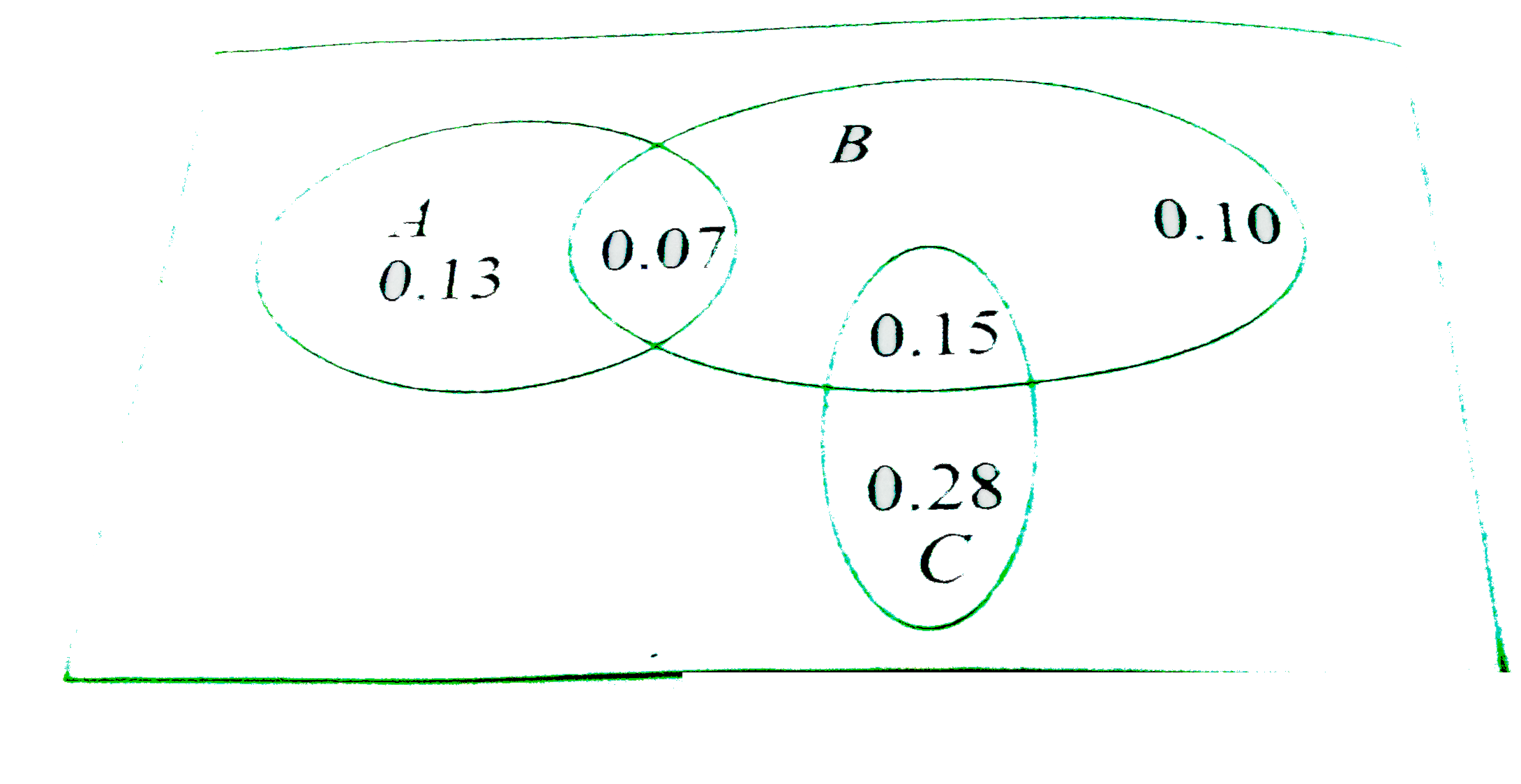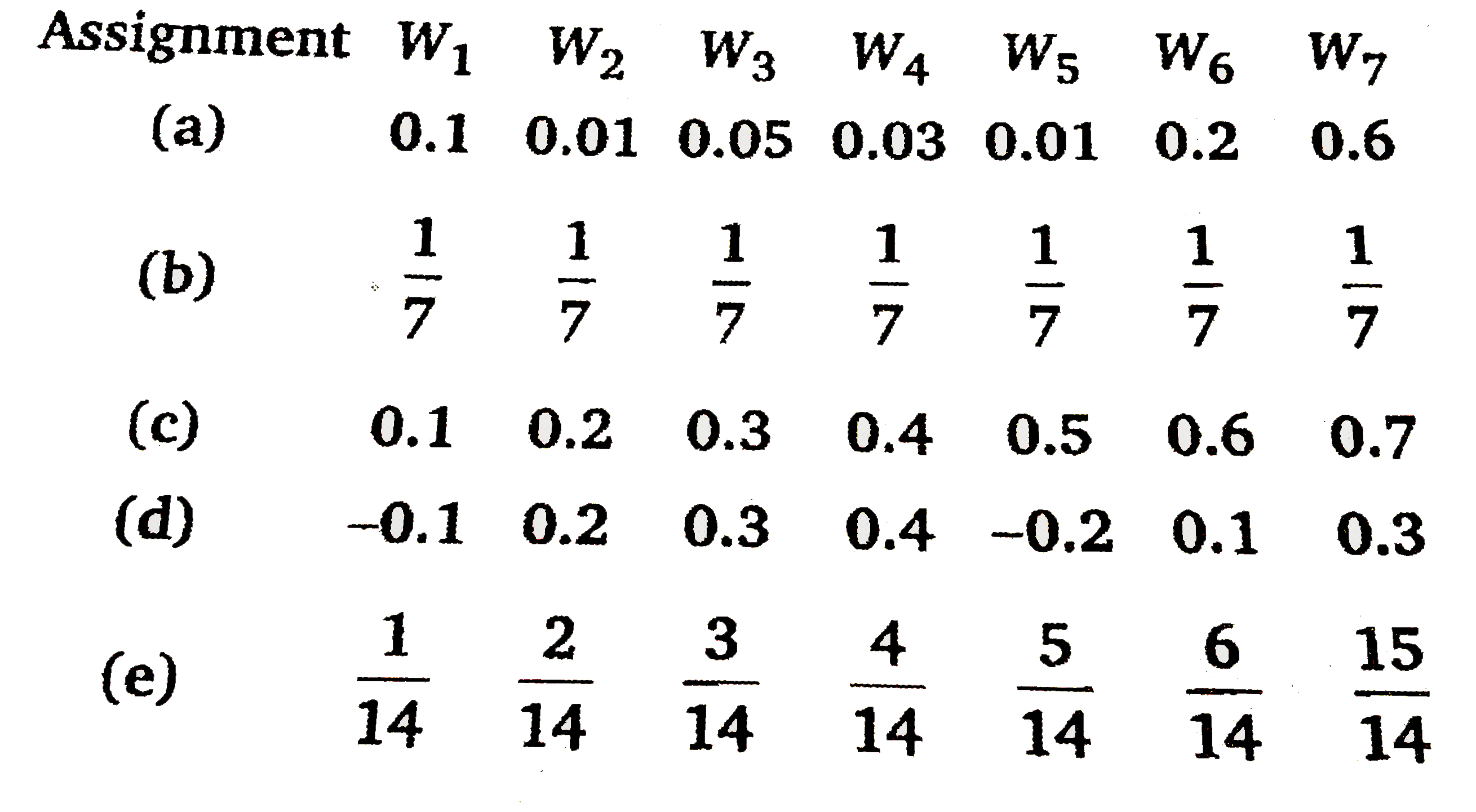The following Venn diagram shows three events, A, B, and C, and also the probabilities of the various intersections.
Determine
(a) P(A)
(b) P(B∩¯¯¯C)
(c ) P(A∪B)
(d) P(A∩¯¯¯B)
(e) P(B∩C)
(f) Probability of the event that exactly one of A, B, and C occurs.
 Solution in Tamil
Solution in Tamil
From the above Venn diagram,
(a) P(A)=0.13+0.07=0.20
(b) P(B∩¯¯¯C)=P(B)−P(B∩C)
= 0.07 + 0.10 + 0.15 - 0.15 = 0.17
(c ) P(A∪B)=P(A)+P(B)−P(A∩B)
=0.13+0.07+0.07+0.10+0.15−0.07=0.45
(d) P(A∩¯¯¯B)=P(A)−P(A∩B)=0.13+0.07−0.07=0.13
(e) P(B∩C)=0/15
(f) P (exactly one of the three occurs) = 0.13 + 0.10 + 0.28 = 0.51
Topper's Solved these Questions
- PROBABILITY I BOOK - CENGAGECHAPTER - PROBABILITY I EXERCISE - Solved Example
1 Videos
- PROBABILITY I BOOK - CENGAGECHAPTER - PROBABILITY I EXERCISE - Exercise 9.1
6 Videos
- PROBABILITY AND STATISTICSBOOK - CENGAGECHAPTER - PROBABILITY AND STATISTICSEXERCISE - Question Bank
24 Videos
- PROBABILITY IIBOOK - CENGAGECHAPTER - PROBABILITY IIEXERCISE - JEE Advanced Previous Year
25 Videos
Similar Questions
There are two bags each containing 10 books all having different titles but of the same size. A student draws out books from the first bag as well as from the second bag. Find the probability that the different between the books drawn from the two bags does not exceed 2.
View SolutionWhich of the following cannot be valid assignment of probabilities for outcomes of sample space S={W1,W2,W3,W4,W5,W6,W7}

View SolutionIf two events A and B are such that P(Al)=0.3, P(B)=0.4 and P(A∩Bl)=0.5, then P(BA∪Bl) equals
View SolutionA signal which can be green or red with probability 45and15 respectively, is received by station A and then and 3 transmitted to station B. The probability of each station receiving the signal correctly is 34 If the signal received at station B is green, then the probability that the original signal was green is (a) 35 (b) 67 (c) 2023 (d) 920
View SolutionIf A, B, C are three events associated with a random experiment prove that P(A∪B∪C)=P(A)+P(B)+P(C)−P(A∩C)−P(B∩C)+P(A∩B∩C)
View SolutionThe probabilities of three events A,B,andC are P(A)=0.6,P(B)=0.4,andP(C)=0.5. If P(A∪B)=0.8,P(A∩C)=0.3,P(A∩B∩C)=0.2,andP(A∪B∪C)≥0.85, then find the range of P(B∩C).
View SolutionLet A,B,C be three events such that P(A)=0.3,P(B)=0.4,P(C)=0.8,P(A∩B)=0.88,P(A∩C)=0.28,P(A∩B∩C)=0.09. If P(A∪B∪C)≥0.75, then show that 0.23≤P(B∩C)≤0.48.
View SolutionFor any three events A,B and C, prove that,P(A uu B uu C)=P(A)+P(B)+P(C)-P(A nn B)-P(B nn C)-P(C nn A)+P(A nn B nn C)
View SolutionIf A; B and C are three events associated with a random experiments then P(A∪B∪C)=P(A)+P(B)+P(C)−P(A∩B)−P(B∩C)−P(C∩A)
View SolutionThe following Venn diagram shows three events, A, B, and C, and also the probabilities of the various intersections.
Determine
(a) P(A)
(b) P(B∩¯¯¯C)
(c ) P(A∪B)
(d) P(A∩¯¯¯B)
(e) P(B∩C)
(f) Probability of the event that exactly one of A, B, and C occurs.

View SolutionIf A, B, C are three events associated with a random experiment, prove that
P(A∪B∪C)=P(A)+P(B)+P(C)−P(A∩B)−P(A∩C)
P(B∩C)+P(A∩B∩C)
View SolutionIf A, B, C are three events associated with a random experiment, prove that
P(A∪B∪C)=P(A)+P(B)+P(C)−P(A∩B)−P(A∩C) - P(B∩C)+P(A∩B∩C)
View SolutionIf A, B, C are three events associated with a random experiment, prove that
P(A∪B∪C)=P(A)+P(B)+P(C)−P(A∩B)−P(A∩C)
P(B∩C)+P(A∩B∩C)
View SolutionIf A, B, C are three events associated with a random experiment, prove that
P(A∪B∪C)=P(A)+P(B)+P(C)−P(A∩B)−P(A∩C)
P(B∩C)+P(A∩B∩C)
View SolutionIf A, B C are three events associated with a random experiment, prove that P(A∪B∪C)=P(A)+P(B)+P(C)−P(A∩B)−P(A∩C)−
P(B∩C)+P(A∩B∩C).
View SolutionIf A and B are two events, then which of the following does not represent the probability that exactly one of A,B occurs is.
(a) P(A)+P(B)−P(A∩B)
(b) P(A∩B')+P(A'∩B)
(c) P(A')+P(B')−2P(A'∩B')
(d) P(A)+P(B)−2P(A∩B)
View Solution
